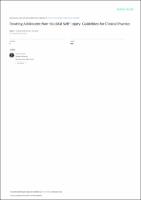Please use this identifier to cite or link to this item:
https://hdl.handle.net/20.500.12202/10115| Title: | Treating adolescent non-suicidal self- injury: Guidelines for clinical practice |
| Authors: | Flaherty, Hanni 0000-0003-0977-0549 |
| Keywords: | Self-injurious behaviors affect millions of adolescents each year, indicating a public health problem needing attention and intervention. Non-suicidal self-injury (NSSI) is the act of purposefully hurting oneself without the conscious intent to die, such as self-cutting, burning, or carving. As the rate of engagement in NSSI is growing among adolescents, mental health practitioners are increasingly faced with responding to NSSI behaviors among adolescent clients. These mental health practitioners must adequately and efficiently identify the behaviors and determine the course of treatment to best support the client and reduce the NSSI behaviors. This article aims to educate practitioners around NSSI behaviors, assessment techniques, and the current evidence-based interventions available to treat adolescents who struggle with NSSI to determine the best practice for this high-risk population by using a case example. Due to the lack of research on NSSI, there is a significant gap in knowledge related to interventions for adolescents who engage in NSSI. Practitioners often report having little training specific to the issues and needs of adolescents who engage in NSSI. Adolescents Non-suicidal self-injury (NSSI) assessment evidence-based interventions selfinjurious behaviors |
| Issue Date: | 2021 |
| Citation: | Flaherty, H. B. (2021). Treating adolescent non-suicidal self- injury: Guidelines for clinical practice. Child & Youth Services, 42 (4), 393-410. https://doi.org/10.1080/0145935X.2021.1938525 |
| Series/Report no.: | Child & Youth Services;42(4) |
| Abstract: | Self-injurious behaviors affect millions of adolescents each year, indicating a public health problem needing attention and intervention. Non-suicidal self-injury (NSSI) is the act of purposefully hurting oneself without the conscious intent to die, such as self-cutting, burning, or carving. As the rate of engagement in NSSI is growing among adolescents, mental health practitioners are increasingly faced with responding to NSSI behaviors among adolescent clients. These mental health practitioners must adequately and efficiently identify the behaviors and determine the course of treatment to best support the client and reduce the NSSI behaviors. This article aims to educate practitioners around NSSI behaviors, assessment techniques, and the current evidence-based interventions available to treat adolescents who struggle with NSSI to determine the best practice for this high-risk population by using a case example. Due to the lack of research on NSSI, there is a significant gap in knowledge related to interventions for adolescents who engage in NSSI. Practitioners often report having little training specific to the issues and needs of adolescents who engage in NSSI. |
| Description: | Scholarly article / Open access |
| URI: | https://hdl.handle.net/20.500.12202/10115 |
| Appears in Collections: | Wurzweiler School of Social Work: Faculty publications |
Files in This Item:
| File | Description | Size | Format | |
|---|---|---|---|---|
| Flaherty_2021_ChildYouthServices.pdf | 920.38 kB | Adobe PDF |  View/Open |
This item is licensed under a Creative Commons License

